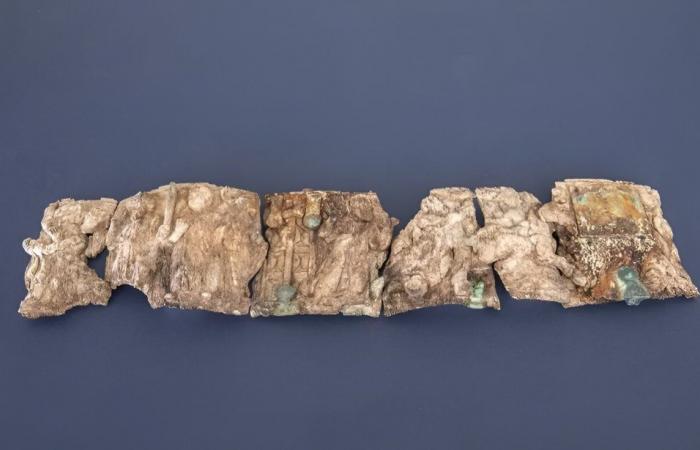A team of researchers from the University of Innsbruck recently made a remarkable discovery in Austria. In an ancient Christian church on a hill in the municipality of Irschen, a 1,500-year-old ivory reliquary was unearthed. This treasure, buried for centuries, reveals little-known religious and artistic practices from late Antiquity.
The discovery of this exceptional, richly decorated artifact poses significant challenges for conservation and analysis, while providing new insights into the cultural exchange and manufacturing techniques of the period. Researchers hope that in-depth study of the materials, artistic techniques and religious symbols depicted on the reliquary will deepen our understanding of the beliefs and practices of this historical period.
The discovery of buried treasure
Since the summer of 2016, archaeologists from the University of Innsbruck have been carrying out excavations at an ancient hilltop settlement in Irschen, southern Austria. This site covers approximately one hectare. It houses remains of dwellings, two Christian churches and a cistern. It provides a valuable window into daily life and religious practices in late antiquity. Research has already revealed several personal items belonging to the former inhabitants. But it was in August 2022 that a particularly spectacular discovery was made.
Fragments of ivory box. © University of Innsbruck
Led by archaeologist Gerald Grabherr, the team unearthed a marble reliquary. It was hidden under the altar of a side chapel of an early Christian church in Burgbichl. Measuring approximately 20 by 30 centimeters, this reliquary contained an ivory box, called a pyxis. It was richly decorated with Christian motifs and very fragmented. He explains in a press release: “ We know of around 40 ivory boxes of this type in the world. And the last discovery during excavations was about 100 years ago. The few existing pyxides are either preserved in cathedral treasures or exhibited in museums. “. This ivory box is considered the most sacred part. In fact, it is usually removed when a church is abandoned. In this case, she was left behind. This provides researchers with a unique opportunity to study this artifact in its original context.
Conservation challenges
Since its discovery, the very fragile reliquary has been transported to the University of Innsbruck for its conservation. Ulrike Töchterle, head of the restoration workshop, explains the specific challenges posed by ivory. This is because ivory, especially when buried in the ground, absorbs surrounding humidity. This makes it very soft and susceptible to damage. “ Ivory, especially that stored in the ground such as in the marble reliquary becomes very soft and easily damaged ». Töchterle specifies: Additionally, uncontrolled drying can lead to shrinkage and cracking, causing irreparable damage “. This situation required a delicate and meticulous intervention to preserve the integrity of the artifact.
Furthermore, due to the very high humidity of 90% in the reliquary, the risk of condensation and mold formation was considerable. To avoid irreversible degradation, the experts implemented a very careful and prolonged drying process. Since the larger pieces of the pyxis were already deformed, it appears impossible to restore the object to its original state. However, the researchers undertook to create a 3D reconstruction of the pyxis to allow for a detailed study. And above all to virtually preserve its original structure. This reconstruction will also provide a valuable resource for future analyses and documentation of this unique artifact.
Interpretations of the reliquary
The pyxis discovered in Irschen is richly decorated with biblical scenes. It perfectly illustrates the religious representations of late antiquity. One of the central figures shows a man at the foot of a mountain, interpreted as Moses receiving the commandments of God on Mount Sinai. This motif is classic and symbolizes the beginning of the pact between God and humanity in the Old Testament.
Close-up: Moses receives the commandments from the hand of God. © University of Innsbruck
Another remarkable scene represents the ascension of Christ, mounted on a two-horse chariot. A hand coming out of the clouds pulls him into the sky. This iconography remains unique. Experts had never observed it before, highlighting the importance and originality of this discovery. The combination of scenes from the Old and New Testaments is typical of late Christian art. But the use of a two-horse chariot, called “biga”, to represent the ascension of Christ, constitutes a particularly notable iconographic innovation.
Close-up: Ascension of Christ on a biga tree. © University of Innsbruck
While archaeologists initially thought that the remains of a saint, i.e. a relic in the classical sense, were also found in the marble box, the superposition of the fragments found indicates that the ivory box was already broken in late antiquity and was buried in the altar.
Uncertain origin of the reliquary and conflicting context
Ongoing analyzes aim to elucidate several aspects of this unique reliquary. Researchers use stable isotope analysis techniques to determine the exact origin of marble and ivory, as well as the elephant from which the ivory came. This approach makes it possible to trace trade routes and sources of materials used at the time.
The metal components of the pyxis, such as the hinges, are also examined to identify the metallurgical techniques employed. In addition, the glue used to assemble the ivory fragments is subject to chemical analysis to understand ancient assembly methods. In addition, fragments of wood found in the reliquary, probably part of the pyxis clasp, are analyzed to determine their type, origin and age. These multidisciplinary analyzes will make it possible to reconstruct the complete history of this artifact, from its manufacture to its use, including its abandonment and rediscovery.
Finally, note that the site of Burgbichl in Irschen, where the reliquary was discovered, represents a hillside settlement dating from late Antiquity. People occupied this site until around the year 610. This period of historical transition is marked by the Battle of Aguntum, a crucial clash between a Slavic army and the Baiuvarii. The victory of the Slavs brought about a radical change in the region, marking the end of its affiliation with the ancient Mediterranean world and Christianity. The new Slavic occupants introduced their own deities and customs, profoundly transforming the cultural and religious landscape.
The abandonment of the Burgbichl site reflects this upheaval, with residents leaving their churches and homes for reasons of security and a change in cultural domination. The excavations carried out by Innsbruck archaeologists then make it possible to reconstruct this pivotal period.






